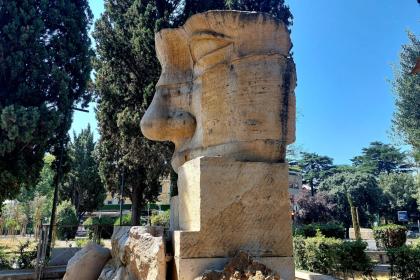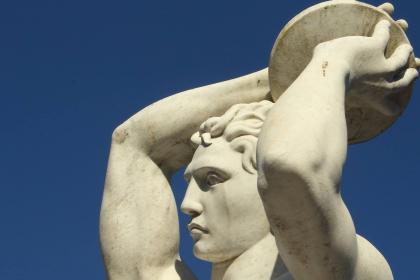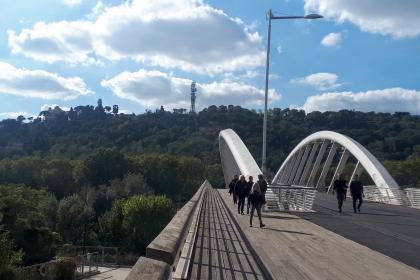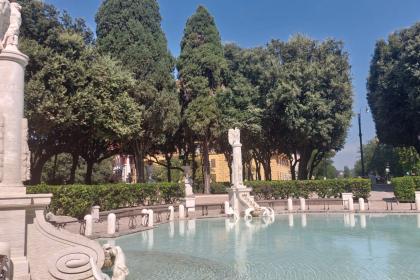
Location
Le « cheval de bataille » du Quartiere della Vittoria
Un quartier élégant et tranquille où les villas et les palais construits dans les années 1920 et 1930 alternent avec des bâtiments et des ouvrages plus modernes, de l'après-guerre à nos jours. Parmi ses larges avenues bordées d'arbres qui descendent vers le Tibre, agrémentées d'éléments décoratifs et de mobilier urbain comme la fontaine des jardins de Piazza Mazzini, se dresse un imposant cheval en bronze patiné, une sculpture d'une grande beauté qui renvoie à la tradition classique et de la Renaissance. Pour les Romains, c'est un élément incontournable du Quartiere della Vittoria mais aussi, bien sûr, le symbole principal et le plus populaire de la RAI, la radio-télévision publique.
De la Bolivie à la Viale Mazzini
Haut de près de cinq mètres et sculpté dans une pose de combat classique, le cheval garde depuis le 5 novembre 1966 les jardins devant le siège historique de la RAI sur le Viale Mazzini, un édifice d'acier et de verre conçu quelques années plus tôt par Francesco Berarducci, élève du célèbre designer Pier Luigi Nervi (à qui l'on doit des chefs-d'œuvre tels que le Palazzetto et le Palazzo dello Sport). La sculpture est l'œuvre de Francesco Messina, auteur de certains des plus importants monuments du XXe siècle italien, et a été conçue à l'origine pour un monument commémoratif dédié à Simòn Bolìvar, leader, homme politique et héros vénézuélien qui, entre 1810 et 1830, a été le principal artisan de l'indépendance de nombreux pays d'Amérique latine, dont la Bolivie, qui porte le nom de son libérateur. Cependant, les coûts de construction élevés et les conditions économiques en Bolivie avaient fait capoter le projet.
Cabré, mourant ou blessé ?
Impressionné par la beauté du projet resté à l'état embryonnaire, le directeur général adjoint de la RAI de l'époque, Marcello Bernardi, a demandé au sculpteur sicilien d'en réaliser une partie, en créant un cheval cabré qui a été installé dans les jardins devant les bureaux de Viale Mazzini, où on peut encore l'admirer aujourd'hui. Les pattes arrière pliées vers le sol, le cheval pointe les pattes avant vers le sol et tourne le museau vers le ciel, ouvert à un hennissement silencieux. C'est en partie à cause de ces caractéristiques que la sculpture est aujourd'hui communément appelée le « Cheval mourant », appellation adoptée par la presse et le grand public à partir des années 1970, après qu'un journaliste eut dénoncé les graves dommages causés à la sculpture par la pollution. Il n'y a cependant aucune certitude quant au destin final du cheval, même dans les intentions de son sculpteur. Lors de sa réalisation à la Fonderia Battaglia de Milan, Francesco Messina l'a décrit comme « un cheval blessé comme après un combat », peut-être donc prêt à se relever et à se battre à nouveau.
Entre moderne et contemporain : d'autres lieux à ne pas manquer dans le Quartiere della Vittoria
De la fontaine-nymphée de Piazza Mazzini à la Déesse Roma d'Igor Mitoraj, fontaine monumentale réalisée en 2003 par le célèbre sculpteur polonais, une promenade dans les rues autour du cheval de la RAI permet de découvrir histoires et curiosités d'un quartier encore peu fréquenté par le grand tourisme, rendu féerique au printemps par les tilleuls en fleurs et à l'automne par les Ginko Biloba. Les édifices publics et privés témoignent de l'évolution de l'architecture romaine en un siècle, du baroque romain au rationalisme fasciste (le complexe du Foro Italico en est un exemple) et au modernisme des années 1960, jusqu'à aujourd'hui avec le Ponte della Musica. À quelques pas de Viale Mazzini se trouve également la Casa Balla, un univers de lumière, de couleurs, de formes et de mouvements périodiquement ouvert au public par le musée MAXXI, et la dernière résidence de l'écrivain Alberto Moravia. Il ne faut surtout pas manquer les cours et les jardins des immeubles résidentiels des années 1920 et 1930, microcosmes verts enchanteurs qui ne sont presque jamais visibles de l'extérieur.
La Dea Roma di Igor Mitoraj

Le Complexe du Foro Italico

 Condividi
Condividi
Pont de la Musique-Armando Trovajoli

 Condividi
Condividi
Fontaine de la Piazza Mazzini

 Condividi
Condividi











































